The Narmada Bachao Andolan (NBA) has consistently raised critical issues concerning women, particularly focusing on the devastating impact of forcible eviction due to large-scale development projects. Beyond the loss of economic resources and livelihoods, women face profound consequences due to such displacement, including the disintegration of cultural, community, and familial ties, the erosion of language, and deep social alienation.
With these profound impacts on women due to the Sardar Sarovar Project, the NBA built strong alliances with women’s movements and organizations across India in the 1990s. The decade of 1990 was also when the women’s movement was powerful and had its presence across the country. NBA maintained that forcible eviction and displacement particularly impact women and it advocated for:
- Women’s special inclusion in rehabilitation policies and laws.
- The right of women to be rehabilitated.
- Right of displaced communities to be part of the decision-making process whenever development projects affecting them are planned.
- Most importantly, the right of people expected to be impacted by development projects to question the very premise of such projects as follows:
– Are such projects justifiable and equitable?
– Are such projects sustainable?
– Who benefits, and who pays the price of such development?
– Are there better, sustainable, equitable alternatives?
Sattalai: The Historic Preparatory Meeting for the Beijing Women’s Conference (1995)
While NBA representatives actively participated in women’s meetings across India during the decade of 1990 putting forth the issue of women and displacement by development projects, a key milestone was hosting a preparatory meeting for the Fourth World Conference on Women, Beijing, held in September 1995.
Preparatory meetings for the Beijing conference were held at different places in India. One of these preparatory meetings was hosted by the NBA where representation and concerns from several movements and NGOs working for the rights of development-induced displaced communities could be discussed at length, made available and ultimately presented at the Beijing conference.
Since NBA did not accept foreign funds, the arrangement was such that NBA hosted representatives of various movements and NGOs, providing food and stay, while the travel costs for many came from a coordinating committee for the Beijing conference, where needed. I vividly recall the preparatory meeting that was held at Village Sattalai, a stronghold of the NBA, located in Dhar district, Madhya Pradesh, from March 26 to 28, 1995. The people of village Sattalai graciously arranged accommodation and food for over 250 women delegates from 44 organizations and movements, who attended the meeting for three full days. The arrangement was that while the women of the Narmada Valley, the NBA and the village Sattalai participated and interacted with representatives from different parts of India in the meeting, all logistical work would be taken care of by the men of the NBA. This was so that women would be free to concentrate on the discussions. And true to their word the senior (men) activists of NBA and of the village Sattalai, performed their duty diligently. During this time, women held discussions, delivered presentations, and collectively finalized a charter of demands to be presented at the Beijing Conference, known as the Sattalai Declaration.
The Sattalai Declaration – Women Against Displacement

Photo Credit: NBA
I had long wished to write about this historic preparatory meeting and the Sattalai declaration, as it marked a landmark in the global women’s and people’s movement, particularly around development induced forced evictions. However, I lacked the Sattalai Declaration text and the full list of participating organizations. All I had was the photo to the left, which seemed insufficient to convey the significance of the event. Besides, although women played phenomenal roles within the NBA, including leadership roles, no woman representative from NBA attended the Beijing Conference itself. Therefore, what happened at the world conference was not known to us as these were pre freely available internet times. But NBA ensured the preparatory meeting was well organized, and the declaration of demands was duly sent to the global platform.
Therefore, it was a delightful surprise when, during my recent (August 2025) visit to the Delhi Forum, a steadfast supporting organisation of NBA, I came across a booklet published by Swashraya (Vadodara) and Vikas Adhyayan Kendra (Mumbai), documenting the Sattalai preparatory meeting and the declaration.
This booklet contains testimonies from women who participated, the list of all participating organizations, and most importantly, the full text of the Sattalai Declaration. I am grateful to Delhi Forum for preserving this priceless 30-year-old record.
The Sattalai Declaration published in form of a booklet titled, “In defence of future”, has the following cover:
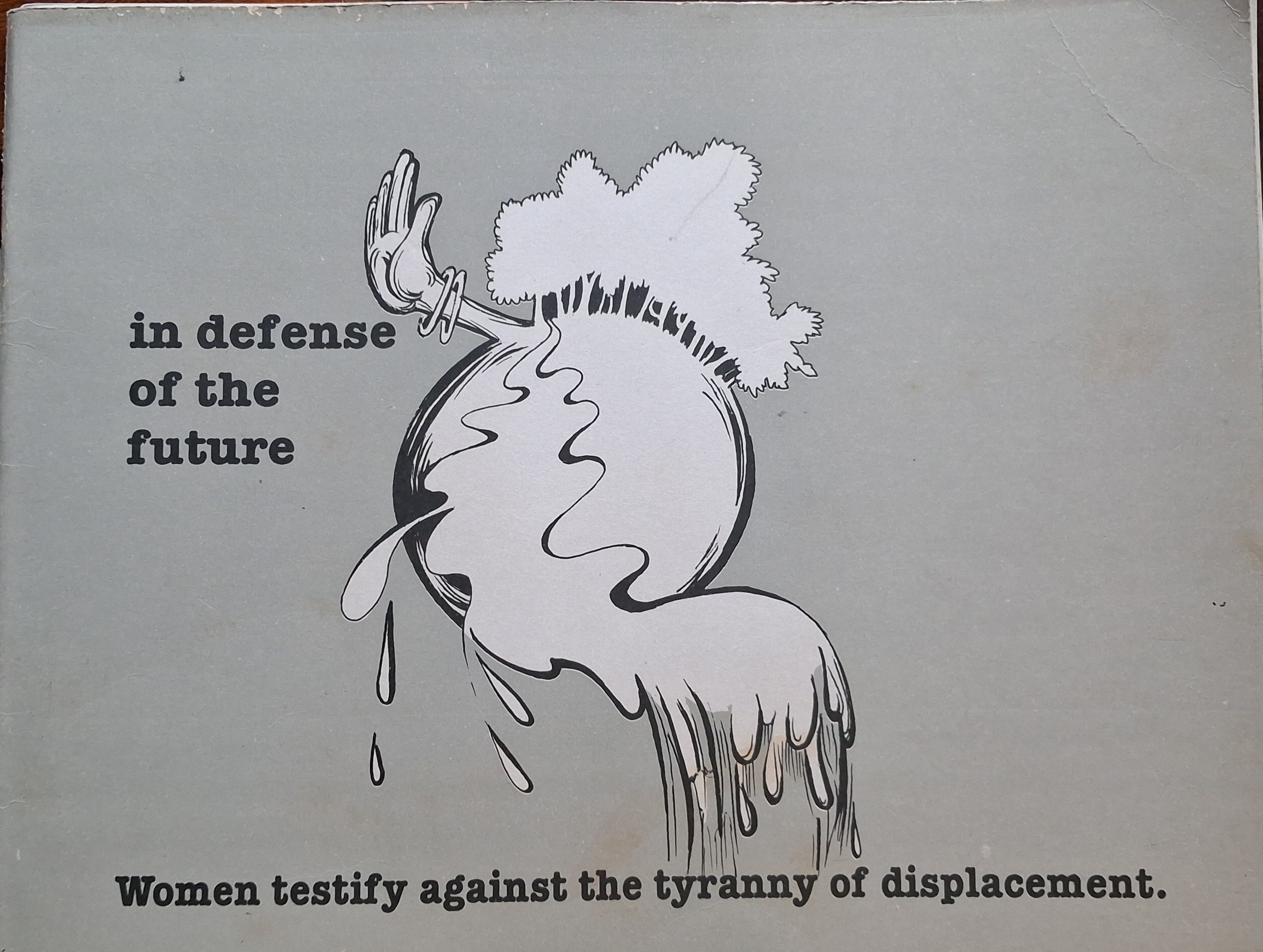
Edited by Bina Srinivasan of Swashraya, one of the firebrand feminists I have known and had the good fortune to have her as my close friend, was one of the steadfast supporters of NBA in Gujarat. She and Swashraya stood by the NBA at a time when the state and mainstream society of Gujarat were hostile and even aggressive against the NBA. The illustrations in the booklet are by another steadfast supporter of the NBA and a distinguished documentary filmmaker, Late K P Sasi.
The booklet edited by Bina begins with a powerful introduction and I reproduce select excerpts here:
“As part of the communities that are affected by and are resisting this development, women have played significant but invisible roles. Movements and struggles which have mobilized a large number of women have also not taken full cognizance of the impact of development on women. It is only now, after years of struggle and devastation that the large scale and far-reaching consequences of growth upon the lives of women are beginning to get noticed.
All of this was proved many times over at Sattalai when as many as 44 organisations and hundreds of women came together on 26-28 March 1995. Sattalai on the banks of the Narmada, parts of which are embarked for submergence due to the Sardar Sarovar Project, was a symbolic choice. For it represents resistance against designs of development, it also represents people’s desire to live and to preserve resources rather than destroy them. The meeting was organized by the Narmada Bachao Andolan with some help from Coordination Unit, Delhi1. …It was for the first time perhaps, that the after effects of displacement, its implications for women were being articulated in this manner… Women have not taken all this without raising their voices or risking their lives. In each of the accounts recorded here there is evidence of whole-hearted resistance. The fact that thousands of women in Bihar have succeeded in halting work on the Netarhat firing range or the Koel Karo dam, that women in the Narmada valley have with their collective strength made it difficult for the state to go ahead with the Sardar Sarovar Project in Gujarat, to give only a few examples, only goes to show that women are indivisibly linked to their lands, forests and cultures and that they do not envisage a future for themselves or their children without them…This report we hope can be a record of women’s experiences and their articulation. Women’s voices are seldom found anywhere at all, despite of their presence in every struggle…We hope that the report speaks for itself and will be useful to activists, individual women, organisations, feminists and academicians alike…This report has been dedicated to Budhiben2, an adivasi woman whose life and death both became symbols of struggle…”.
1. Coordination unit for Beijing conference
2. Late Budhiben, the first martyr of NBA who lost her life fighting. She belonged to the submergence village Antras in Gujarat, one of the 19 villages to submerge in the Sardar Sarovar Dam in the state. She led an unprecedented struggle against the might of the state of Gujarat against her forced eviction from her village, for which, she was subjected to unimaginable repression. She ultimately lost her life fighting during the course of her struggle.
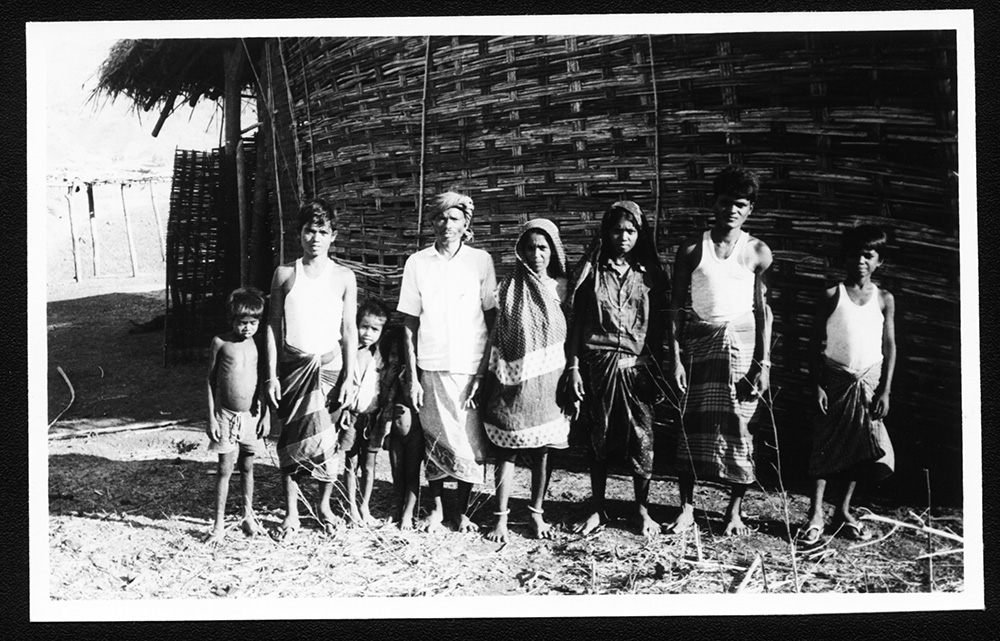
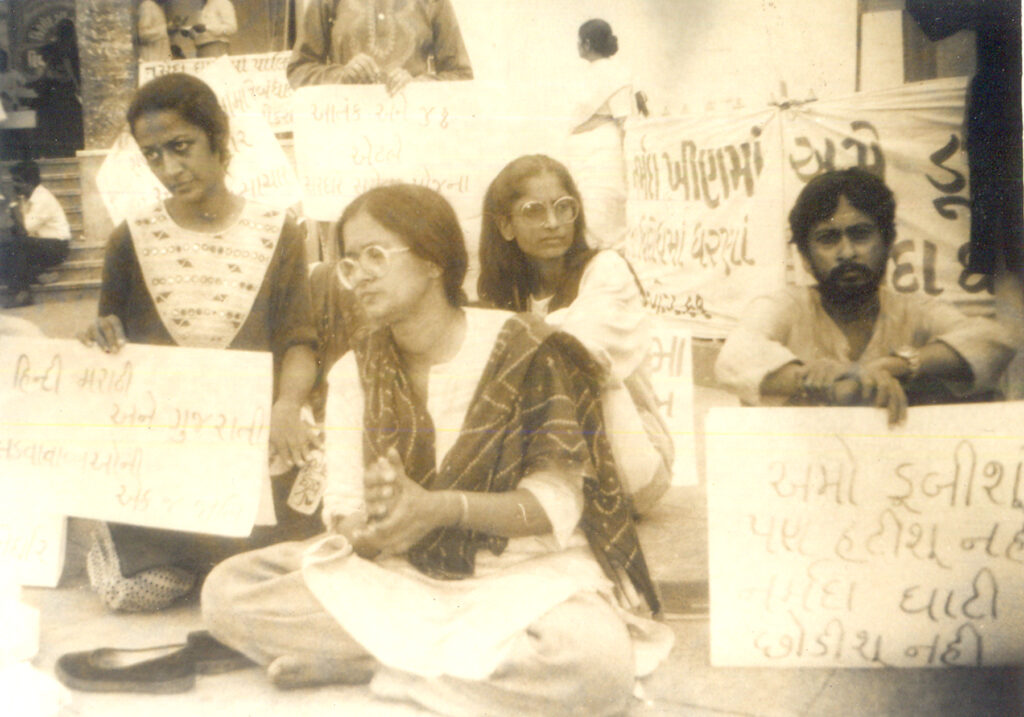
Detailed Testimonies of Women Activists recorded in the booklet are by the following:
- Ansuya-YUVA, Dharavi, Mumbai
- Arundhati (Dhuru)-Narmada Bachao Andolan, Maharashtra
- Asha Singh – Gwalior Science Centre, Gwalior, Madhya Pradesh
- Basantibai – Bargi Dam Visthapit Sangharsh Samiti, MP
- Basikaki- (Narmada Bachao Andolan) Vadgam, Gujarat
- Bharti- YUVA, Mumbai
- Bhawaribai– Bilaspur Bandh Sangharsh Samiti, Tonk, Rajasthan
- Bina – Swashraya, Gujarat
- Dipti – Sipu-Dantiwada Bandh, Banaskatha, Gujarat
- Geeta – Manav Kalyan Trust, Gujarat
- Indirabai – Bhimghar Dam Sangharsh Samiti, MP
- Jagnmani Topno – Koel Karo Dam, SCMI, Bihar
- Jashodaben – Kadana dam, Rajasthan
- Jayshree Bhalerao– Khedut Mazdoor Chetna Sangathan, Alirajpur, Madhya Pradesh
- Jyotsna Sheela Dang – Netarhat Field Firing Range, Bihar
- Kamal – YUVA, Mumbai
- Kamludidi – Narmada Bachao Andolan, Nimad, Madhya Pradesh
- Kanta – Mahi Kadana Dam, Gujarat
- Kanta Marathe – Ekta Parishad, MP
- Kaushalya Pawar – Bhimghar Dam Sangharsh Samiti, MP
- Manimala- Jharkhand
- Monica Roy – Piparwa Coal Fields, Karanpura Ghati Bachao Andolan, Bihar
- Munnibai- Adivasi Mukti Sangathan, Madhya Pradesh
- Nandini (Oza) – Gujarat Visthapit Sankalan Samiti, Gujarat
- Niti Diwan – MP Mahila Manch, MP
- Pramila – FARR, Orissa
- Pervi- Narmada Bachao Andolan, Jhabua, Madhya Pradesh
- Rajubhai – Gujarat Visthapit Sankalan Samiti, Gujarat
- Sanabhai – Panam Dam, Gujarat
- Sumita- Indira Gandhi Canal, Rajasthan
- Undali- Khedut Mazdoor Chetna Sangathan, Jhabua, Madhya Pradesh
- Usha – Swashraya, Gujarat
These many women representatives and many more from so many organisations fighting development induced forced eviction, at the end of three-day deliberations brought out the following declaration to be sent to the conference at the 4th world conference on women at Beijing in September 1995:
“The Sattalai Declaration Women Against Displacement – We – Adivasi, peasant, worker, artisan, slum-dwelling women, have gathered today on 28 March 1995 at Sattalai on the banks of the river Narmada to share our experience of displacement. In conclusion, we declare,
1. Big dams, factories, mines, power plants, nuclear plants, and other such demonic projects that have come up all over the country for the so-called development of the nation are taking over our water, forests, lands, and other resources. They are bringing in its wake many kinds of displacements, all of which affect us severely.
2. Forest policies, sanctuaries, and national parks are destroying our rights to forest and forest produce. In addition, our rights over life-sustaining resources like fuel, water, and fodder are being erased. It is women who bear the brunt of this entire process of inhuman development. On the one hand, our traditional rights and knowledge systems concerning use and protection of basic resources like fodder, forest produce, medicines, seeds, and trees are being systematically and undemocratically wiped out. This has increased the burden of our work tenfold. On the other hand, our rights and responsibilities towards the development of the family, society, and nation are being severely restricted. Patriarchy has in any case reduced us to secondary citizens, but now modernization and the new economic policies together have made the lives of women even more difficult.
3. Capital is being centralized in the country. It is only a few areas and sections that receive the benefits of development. For this, natural resources and labor power of other areas and sections of people are being relentlessly exploited. This centralization is increasing regional imbalances. As a result, regional and local identities are constantly under attack and are being distorted beyond recognition. Women suffer the most because of this. Our spheres of decision-making are shrinking drastically. Our freedom is being put under an increasing plethora of controls.
4. Migration has increased manifold because of unequal regional development. Women already burdened with migration as adivasis, dalits, laborers, and peasants face additional oppression because of sexual exploitation and discrimination of unequal wages. The disintegration of our communities, homes, and families has increased insecurity.
5. Capital-intensive mechanization in agriculture is being introduced on a large scale. This causes unemployment, which hits women first, along with displacement from our villages, lands, and homes. We face displacement from traditional occupations also. What we get in turn are strenuous, time-consuming, low-paid, and low-skilled jobs with no fixed working hours and little scope for individual growth.
6. Women are considered to be protectors of natural resources and of society as a whole. But the current development policy, coupled with the new economic policies and migration, have snatched away these rights from us. As a result, society is confronted with the destruction of natural resources on the one hand, and on the other, the increasing threat of breakdown of all social structures. There has also been an increase in the use of machines, chemicals, techniques that destroy land, pump the air with poison, affecting our health, reproductive capacities, including foetuses, and causing mental and physical disabilities in humans as well as animals.
7. The breakdown of our villages, families, and communities has an adverse impact on regional diversity, traditional cultures, human relationships, aspirations, and entire lifestyles. Distance from our natural homes, displacement disperses our families. This distorts relationships between women and men. It destroys mutual trust and reduces our mobility and freedom. Anti-women practices and society evils like witch-hunting are on the increase.
8. Driven off from our villages, we come to cities. We build homes on footpaths and slums. Here, even the basic minimum necessities like shelter, water, toilets, and electricity are denied to us. Urbanization and beautification of cities become reasons for being driven off once again from our lands. Displaced once, we face displacement repeatedly. We are in flight for the rest of our lives. Gundas and police alike harass us. We are thought to be criminals and thieves. To survive, we are forced at times to sell our bodies, self-respect, and integrity.
9. Many government schemes have come up in the name of women’s development. Infrastructure and budget allocations are increasing, but on the other hand, the status of women is continuously being downscaled. According to a statement made by a water resource minister, approximately 2 crores of people have been displaced by various development projects undertaken after independence. Of these, only 60 lakh have been compensated and rehabilitated. The other 1.5 crores, half of which are women, are missing. There is no information about them. 80 lakh women have disappeared and yet it is claimed that there has been women’s development in the country.
10. We have not gathered here to discuss the impact of these anti-women and anti-people policies and development projects only to cry over our sufferings. We do not speak only as victims. We have also raised our voices in protest. Our presence here is a testimony to the struggles waged by thousands of women and men against destructive projects that have besieged them and their lives. Many have won in their struggles. Balyapal, Netarhat, Narmada, Chhattisgarh, Bilaspur are some areas and organizations where women have participated equally. Even as they fulfilled domestic responsibilities, take care of children, they have set aside the fear of defamation and have participated fully in struggles.
11. We feel that participation in struggle alone is not enough. We should also take the leadership. We have to make important decisions in life and struggle. We have to lead organizations and change the direction of its growth. For this, we will have to change unequal relationships in the house, unequal distribution of work and the societal framework of looking at women.
12. We are clear that present-day development is anti-people, anti-women. It is meant to benefit only a favored few. We will get together to fight against it. We will also oppose international financial institutions like the World Bank that give financial support to beautify cities or make big dams.
13. We are struggling for our rights to live and for the lives of the coming generations. We accept the challenge, long and tough struggle ahead of us. We will create a society that is based on equality and is harmonious with nature where each one of us has a place.
Date 25 March 1995, Place Sattalai, District Dhar, Madhya Pradesh.
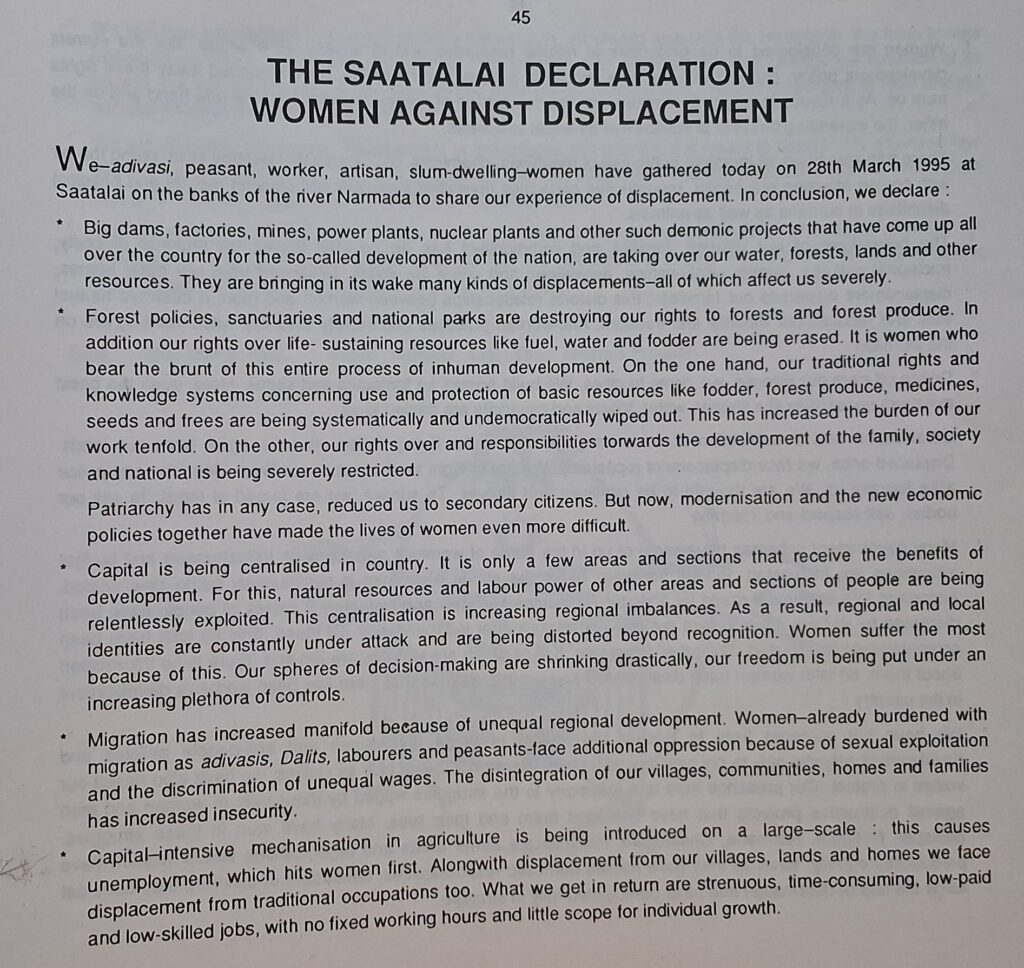
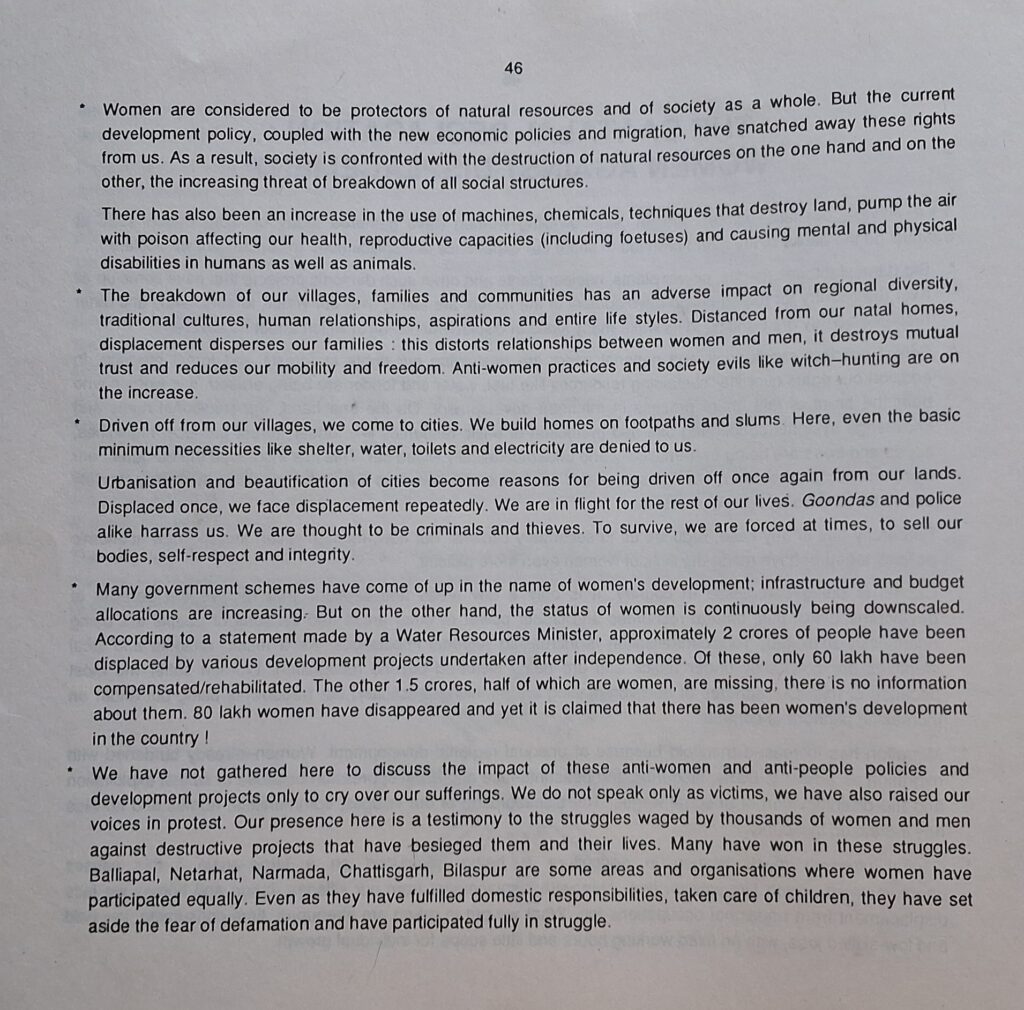

The list of organisations and movements and their representatives listed in the booklet are as follows:
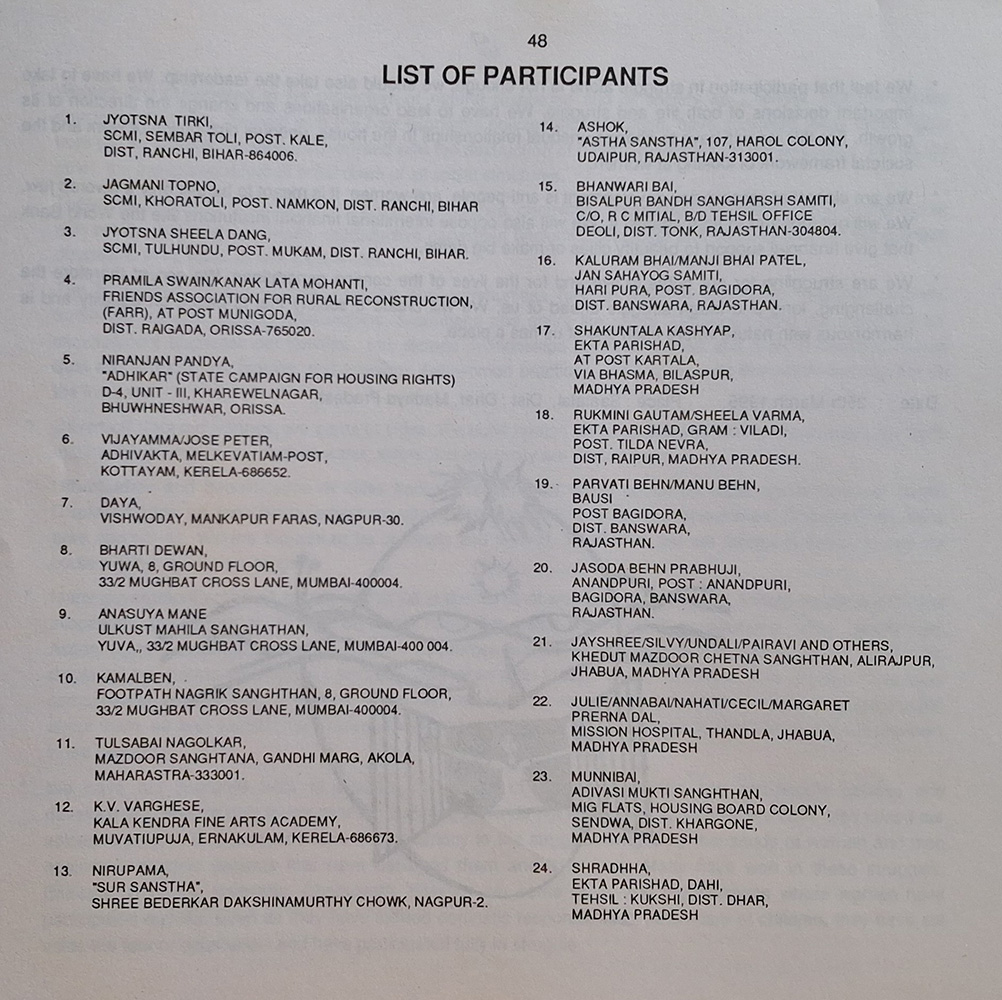
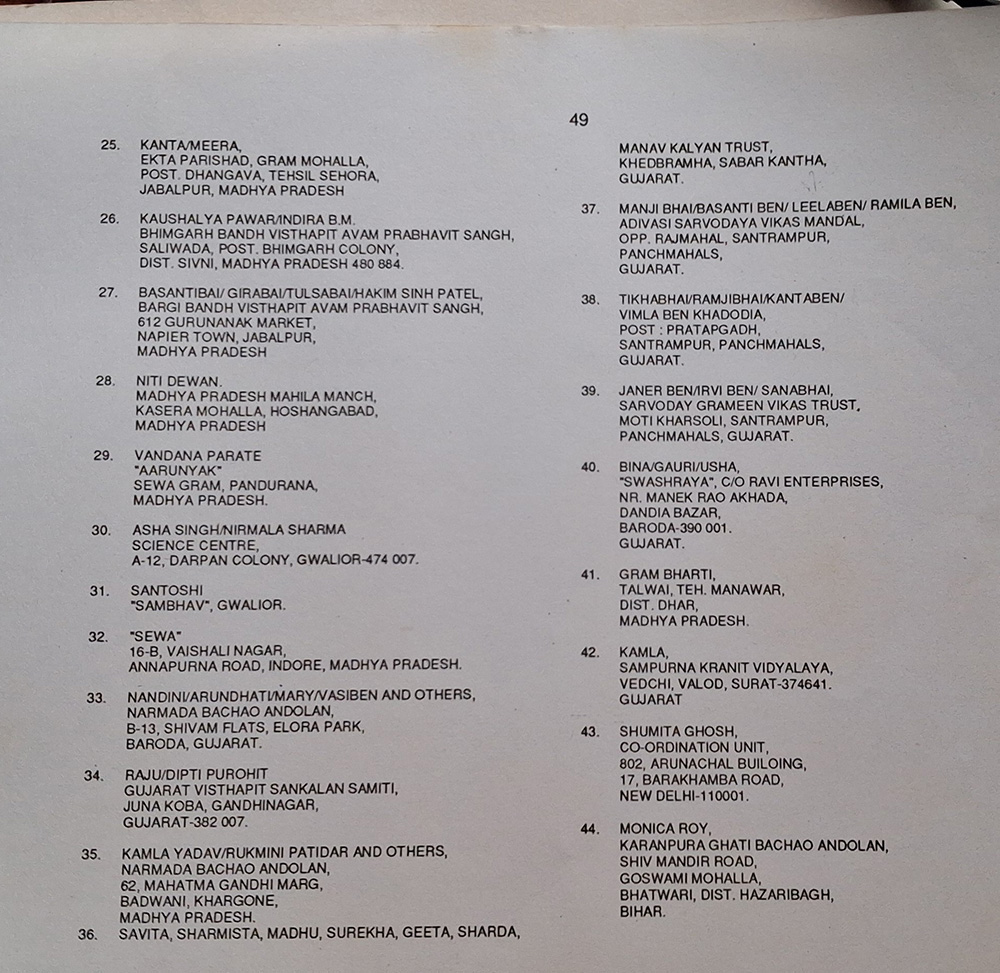
Significance of this compilation and sharing
I consider this preparatory meeting at Sattalai and the Sattalai Declaration dated 25 March 1995 a landmark in women’s movement and people’s movements like the NBA, to have jointly brought development induced forced eviction and displacement to center stage in India and even globally to a large extent.
I do hope that this documentation now online, 30 years after having been published will remain an important record for people’s struggles against forced evictions and women’s movements, as well as their contribution in the larger debate around development in India that continues even now.
Nandini Oza
19-September- 25